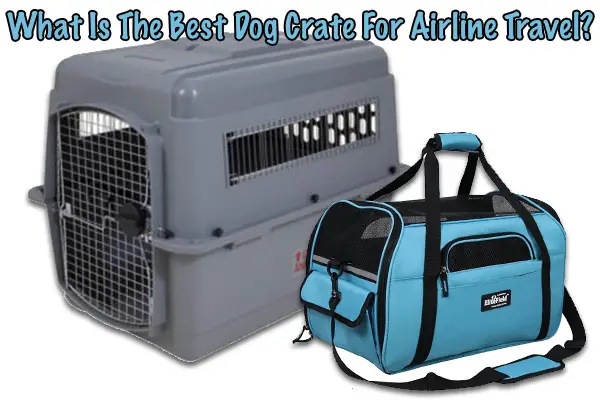
Taking your dog on an airline for the first time can be an overwhelming thought. While it is not impossible, you do have a lot of things to consider. One of them is choosing the best crate or pet carrier. Perhaps you know by now that not all dog crates are compatible or suited for airline travel. So, if the goal is to put your dog inside it for air travel, then your foremost consideration is that it should be airline approved.
Lucky you since there are a handful of dog crate options out there. It does not take a rocket scientist to find the best dog crate for airline travel, but you do need to understand the available choices since not all carriers and crates are allowed.
Types of Dog Crates
Dog crates come in two varieties – one made from hard material and the other with soft components or sides. A pet carrier made from hard material is more durable and offers better protection. Most hard dog crates are approved for air travel. However, you most likely will declare your dog as cargo. What it means is that you cannot bring the animal inside the cabin. Even if your dog is not beside you during the flight, you at least are confident that the animal is well-protected by the dog crate made from hard and solid material.
On the other hand, some soft-sided dog carriers are designed for airline approval. The advantage of choosing this variety of dog crate is that you can put your dog inside it and bring it in the cabin. But be reminded that soft-sided pet carriers are mostly intended for small and medium-sized breeds.
Soft-sided dog carriers are only meant for pets that remain calm during air travel. Sadly, most dogs will panic in their first experience of air travel. The problem is that they usually bite, chew, or munch on something when they are stressed. So, if your dog does not feel comfortable during transport, then you should not buy a dog crate made from soft material.
Airline Requirements for Dog Cargo Crates
There are highly specific (and strict) rules that govern how pets like dogs should be handled during air travel. These rules created by the International Air Transport Association (IATA) include specific qualifications for a compatible container. What I am going to discuss in this post are the general rules which are accepted by most airlines. I strongly recommend that you inquire about a specific airline’s pet policies before you go to the airport with your dog.
Dogs Traveling as Cargo
There are two available options when taking your dog on a flight – you can opt for checked baggage or cargo. Regardless of the viable option, the airline is responsible for creating the ideal environment and temperature to ensure the animal’s safety and survival. Large aircraft accept live animals as part of the cargo since they have special provisions to guarantee safe handling. However, not all airline companies accept pets as cargo, so you must put in the extra effort to call them ahead of time.
Strict Requirements for Cargo Crates
Just because an airline company accepts your dog as cargo does not mean that you can bring it on board without a carrier or crate. It would help if you had an IATA-compliant dog crate, and it should also be airline approved. In other words, the carrier must have the dimensions and safety features that meet the standards of both IATA and your airline.
Although you can put two small dogs in a crate, I strongly advise against it. It is almost impossible to guarantee the dog’s comfort when it is forced to share a congested space.
Minimum Crate Requirements
The best dog crate for airline travel must be large enough for your pooch to stand, lie down, stretch, and turn comfortably. This rule applies to all dog breeds and sizes. So, if you are planning to bring a large breed like a Great Dane or Labrador Retriever, then you will need a sufficiently large crate, too. The problem with large dogs is that you can never choose the in-cabin option since your four-legged buddy will not fit under the seat. Only small dog breeds like a Chihuahua or Terrier may qualify for in-cabin flights.
You get to choose from a wide range of material options. A dog crate designed for airline travel can be made from metal, fiberglass, wood, rigid plastic, and fabric. If you choose metal, wood, or rigid plastic material, then prepare yourself to carry a heavy load, especially with the dog inside. The advantage of fabric and fiberglass is that they are lightweight. But as I said earlier, you cannot settle for a soft-sided crate if your dog likes to chew on things when it panics or is stressed out.
Be sure to get a dog crate with a stable and solid floor. It also must be leak proof, but you will know that once you read the standards set by the airline company. The best dog crate for airline travel must also have a secure door, preferable something that is spring-loaded and with lock reinforcements.
Some airlines will require a crate that is not collapsible in design, while the roof must be solid even with vents or mesh for air circulation. Water and food bowls are a necessity if you are bringing in your dog as cargo. These bowls should be attached to the interior of the front door, but refillable from the outside. The purpose is for you to refill the bowls without the need to open the door.
Finally, ventilation is crucial since you do not want your dog to feel claustrophobic during the trip. You also do not want the animal to suffocate because of the lack of air. Buy a dog crate for airline travel with ventilation on two sides. If you are on an international flight that takes at least three hours, then go for a dog crate with ventilation on all four sides.
The post What Is The Best Dog Crate For Airline Travel? appeared first on Furry Friends Gear.

No comments:
Post a Comment